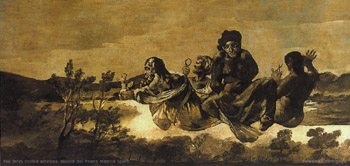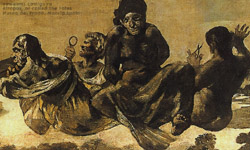The Black Paintings - Atropos FOR THE UPDATED CURRENT PAGE PLEASE GO HERE
The
Black Paintings 1820-23
Oil on gesso transferred to linen "...Goya again includes a small number of clues that suggest a classical myth, only to contradict such a conventional interpretation. In this case we see hovering, floating figures, one of which is intent upon spinning, while another holds a pair of scissors aloft. The action of the central figure is indecipherable but might be interpreteed as measuring and winding the thread of life. The spinning and the cutting of thread are immediately reminiscent of traditional renditions of the Three Fates. But Goya destroys this easy interpretation by including a fourth figure that cannot be explained away. This figure prominently displays what might be either a lorgnon or a magnifying glass. It may well be that Goya began this painting, as well as the Saturn, with a fairly definite theme in mind, which was then altered and superceded by the obsessive and inexplicable intervention of a more personal and enigmatic symbolism that rose to the surface while the artist worked." Fred Licht, from his book Goya, published by Abbeville Press 2001, page 221.
|
- - - - - - - - - - - - - - - - -
- - - - - - - - - - - - - - - - -
WEB SITE COPYRIGHT©1997-2006 ERIK E. WEEMS
IMAGES ARE COPYRIGHT TO THEIR RESPECTIVE OWNERS
http://www.eeweems.com/goya/atropos.html
BIO | ARTWORK | BOOKS | RESOURCES FOR STUDENTS | LINKS | CONTACT | NEWS | STATS | F.A.Q.


